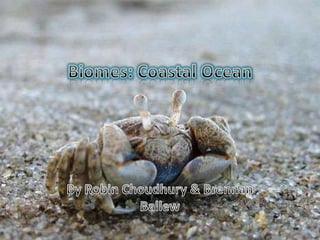
Coastal ocean
- 1. Biomes: Coastal Ocean By Robin Choudhury & Brennan Ballew
- 2. Introduction A coastal ocean is a biome in which the land meets the water and contains the shallow portion of the ocean. Plants and animals in this biome have adapted to the land being so close to the water. This biome includes coral reefs and mangrove habitats, found only in tropical waters.
- 3. Climate Elevation: 18 ft Average yearly wind speed: 11.3 mph Salinity:34 parts per thousand
- 4. Organisms Animalia-barnacle, Greenland shark, jellyfish, lobster, crab Plantae-coastal sandalwood, caper bush, bracken fern, douglas iris, California buttercup, California poppy, sea palm, Turkish towel, rockweed, sea lettuce, feather boa kelp, Codium fragile, giant kelp, bull kelp, eelgrass, surfgrass Fungi-Gloiocephalaepiphylla, Marasmiellusmesosporus Protista- amoeba, paramecium, algae Eubacteria- Cyanobacteria Phyla , Spirochetes Archaebacteria-
- 5. FoodWeb Plankton Polar Cod Pelagic Crustaceans Sun Squid Ringed Seal Arctic Fox Polar Bear Mycobacterium Bearded Seal
- 6. Cycles Water Cycle- The water cycle is the main factor that keeps the ocean going. Water is evaporated on land, then carries to the sky to condensate into clouds, then falls back into the ocean to start the process all over again. The water cycle is never ending, so the organisms in the ocean don’t have to worry about losing their home because water is an inexhaustible resource. Carbon Cycle- The carbon starts out underground, and then humans drill wells to bring it up from the ground, and then the fossil fuels are burned and they rise to the sky. Coal is also stored under volcanoes, and then when they erupt, the fuels are emitted into the air, and then also rise to the sky. The carbon then condensates in the clouds and then falls back into the ocean in the form of precipitation and the cycle restarts. Nitrogen Cycle- This is how nitrogen is continuously recycled. It makes up the majority of the atmosphere around us, and is used by many organisms. Nitrogen is used, then moves somewhere else to be fixed by nitrogen fixation. This can happen a couple of ways, usually by atmospheric fixation (lightning) or bacterial fixation. Then it is moved to detrivores and goes through denitrification. Then it is once again used by animals and plants.
- 7. Symbiosis In the case of the pilot fish and a shark, the pilot fish cleans sharks of parasites, so the shark gets cleaned and the pilot fish gets a free meal. This is an example of Mutualism. As the whales travel the barnacles gain access to nutrient-rich waters, yet their host neither benefits nor is harmed by its riders. This is an example of Commensalism A copepod attached to a Greenland shark. The copepods damage the cornea of the Greenland shark, and this can include a 50% thickening of the limbus epithelium, inflammation, and massive edema of the corneal cells. This is an example of Parasitism.
- 8. Disaster The consequences that would result from a hurricane in our coastal ocean biome are severe. The hurricane could kill many animals and plants which would upset the balance of the biome. If a hurricane took place on the coast, then objects on land could end up in the ocean which would harm the environment even more. Obviously, with the high wind speeds and water everywhere, it could end in casualties of animals everywhere. Hurricanes also cause dramatic rise of the sea level and massive rainfall, which causes floods.
- 9. Primary/ Secondary Succession Primary succession is the destruction of an environment resulting in the environment being devoid of soil, animal, and plant life. Because this particular environment has to deal with water, water is displaced and imbalanced, upsetting the balance of the whole entire biome. An example of primary succession would be if a volcano erupted near the coastal ocean. The magma would surface, becoming lava, which would then come in contact with the water. This causes the lava to dry and create land. Over time lichens will grow. Eventually more and more plants will grow, like shrubs and trees. Then, animals will come to populate it, and an environment is born. Secondary succession is when land is already there, destroyed, and built again. So if a volcanic eruption destroyed the coast of an ocean, small plants would grow again, until bigger plants grew, and animals populated it.
- 10. Conclusion In conclusion, the coastal ocean is a biome with a balanced mix of land and aquatic elements. It is self-sufficient, and is able to adapt to almost any circumstance.